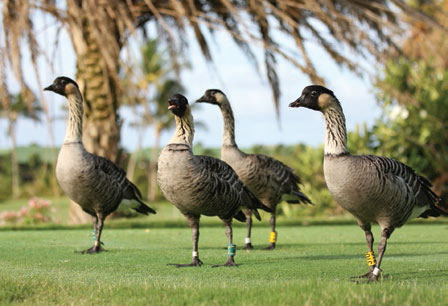The annual migration of the Humpback whale is celebrated in the Hawaiian Islands, and sightings are reported on the nightly news when the big mammals begin to arrive in local waters each fall. The Pacific Golden Plover (kolea in Hawaiian) makes the same migration between Hawai`i and Alaska each year, heading north in spring and south in fall. Though they are not rock stars like the Humpbacks, their journey is perhaps even more amazing, as they wing their way thousands of miles without any land on which to stop, rest, and refuel.
Shoreline and Golf Course Birds

“The Pacific Golden Plover is quite a remarkable bird,” says Lance Tanino, founder of Manu Conservation Birding and Nature Tours and one of the leading birding experts in Hawai`i. “They fly nonstop for three or four days to nest in the tundra of Alaska, and make the return trip to Hawai`i starting around August. The adults come first with the juvenile birds following shortly thereafter.”
Seen regularly around the waterfront areas and golf courses of Waikoloa Beach Resort, Tanino says the Pacific Golden Plover (pictured left) is one of the few native species to have thrived after human contact, as the clearing of the underbrush near the beaches and the ponds and grassy areas of the golf courses make excellent habitat for these birds.
Another frequent visitor to Waikoloa’s golfing greens is Hawai`i’s state bird, the Nēnē Goose. A year-round resident in the islands, the Nēnē is still considered an endangered species, but their population has increased significantly since the 1940s when — due to relentless human hunting and the introduction of mongooses and feral cats to the state — they were effectively extinct in the wilds, and estimates put the number of birds at fewer than 10. A captive breeding program centered on Hawai`i Island, coupled with another breeding program in England, managed to rescue the Nēnē from extinction, and by the late 1970s there were more than 2,000 of the distinctive geese with deeply furrowed neck feathers in captivity and ready to be released into the wild once again.
“They are doing better with the extensive protection by the federal and local authorities,” Tanino says, “and they love the short grass of the golf courses.” But Tanino also points out that golfers need to understand that the Nēnē are sometimes territorial and they should avoid contact with them or their chicks.
Another unique bird that guests at Waikoloa Beach Resort will also observe is the Black-crowned Night Heron (‘auku’u), a non-endangered resident bird that likes to sit on tree snags or stalk the lava rocks above the tidepools looking for fish. With its long legs and sturdy gray body, this bird appears almost hunched as it patiently and quietly goes about its business of catching fish.
“Interestingly” says Tanino, “the Black-crowned Night Heron has learned to attract fish using bread. It’ll drop the bread in the water and wait for fish to come take the bait.”
Keen-eyed birders can also spot the Ruddy Turnstone (‘akekeke), the Sanderling (huna kai, literally translated as “sea foam”), and the Wandering Tattler (‘ulili), all migrating visitors to Hawai`i’s shores. And if you’re really lucky, on the deserted stretches of sand south of Lava Lava Beach Club, you may catch sight of the elusive Bristle-thighed Curlew (kioea, named for the loud whistling sound it makes), a long-billed bird that prefers solitude as it molts all of its flight feathers before migration and is flightless and vulnerable to predators for a period of time.

